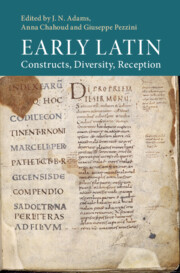Book contents
- Early Latin
- Early Latin
- Copyright page
- Dedication
- Contents
- Illustrations
- Tables
- Contributors
- Acknowledgements
- Abbreviations
- Chapter 1 Introduction: What Is ‘Early Latin’?
- Part I The Epigraphic Material
- Part II Drama
- Chapter 5 Metre
- Chapter 6 Morphology and Syntax
- Chapter 7 Support Verb Constructions in Plautus and Terence
- Chapter 8 Ecquis in ‘Early Latin’
- Chapter 9 Indirect Questions in ‘Early Latin’
- Chapter 10 Latin edepol ‘by Pollux!’
- Chapter 11 Early Latin Lexicon in Terence (and Plautus)
- Chapter 12 A Comparison of the Language of Tragedy and Comedy in Early Latin Drama
- Part III Other Genres and Fragmentary Authors
- Part IV Reception
- Bibliography
- Index Verborum
- Index of Non-Latin Words
- Index Locorum Potiorum
- Subject Index
Chapter 12 - A Comparison of the Language of Tragedy and Comedy in Early Latin Drama
from Part II - Drama
Published online by Cambridge University Press: 27 July 2023
- Early Latin
- Early Latin
- Copyright page
- Dedication
- Contents
- Illustrations
- Tables
- Contributors
- Acknowledgements
- Abbreviations
- Chapter 1 Introduction: What Is ‘Early Latin’?
- Part I The Epigraphic Material
- Part II Drama
- Chapter 5 Metre
- Chapter 6 Morphology and Syntax
- Chapter 7 Support Verb Constructions in Plautus and Terence
- Chapter 8 Ecquis in ‘Early Latin’
- Chapter 9 Indirect Questions in ‘Early Latin’
- Chapter 10 Latin edepol ‘by Pollux!’
- Chapter 11 Early Latin Lexicon in Terence (and Plautus)
- Chapter 12 A Comparison of the Language of Tragedy and Comedy in Early Latin Drama
- Part III Other Genres and Fragmentary Authors
- Part IV Reception
- Bibliography
- Index Verborum
- Index of Non-Latin Words
- Index Locorum Potiorum
- Subject Index
Summary
This chapter examines aspects of coordination in the language of Latin prayers. The general question addressed concerns the sense in which ‘early Latin’ features manifest themselves in prayers, and whether the term ‘early Latin’ is an appropriate designation of any peculiarities of prayer coordination. The results of the inquiry on ‘early’ prayers in the corpus considered in the chapter is that asyndeton bimembre, though in use, was not in high fashion, and that end-of-list coordination was preferred to long asyndeta and multiple coordinations, a preference that is the reverse of that of genres other than prayers in the early period and later.
- Type
- Chapter
- Information
- Early LatinConstructs, Diversity, Reception, pp. 251 - 272Publisher: Cambridge University PressPrint publication year: 2023

